Yangtze River Cruise
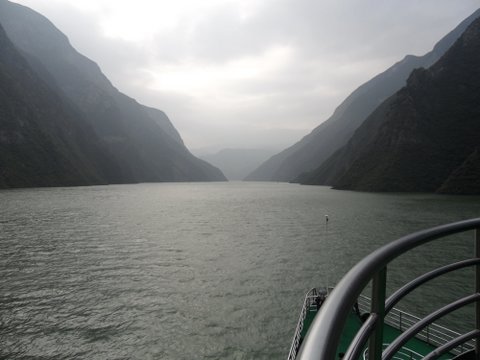
A cruise on the Yangtze River in China is nothing like a voyage on an ocean going cruise ship and has little in common with a river cruise in Europe. Rather, it’s more like an expedition cruise, particularly in that the destination is the focus more than the vessel that conveys you there.
The Yangtze is the longest river in China and the third longest one in the world, after the Amazon and the Nile rivers. It originates in Tibet and gathers water from over 700 tributaries as it flows 3,900 miles east to the East China Sea near Shanghai. Since olden days, it has been China’s lifeline and major thoroughfare of transportation and commerce. For most travelers, the highlight is the magnificent scenery of the Three Gorges. But as I discovered, the cruise also unveils attractions as varied as ancient temples, unusual museums, spectacular mountain formations, and the 21st century pride of Chinese engineering.
When I learned the Yangtze River cruise I would be taking, leaves from Chongqing in western China, I assumed it was a rural, middle-of-nowhere river town, but that only reflected my limited knowledge of western China. When, to my great surprise, I discovered Chongqing has a J.W. Marriot Hotel, I knew I needed to do some homework.
Chongqing, the starting point for downstream Yangtze River cruises, is the capital of a province by the same name with a population of 33 million. The city’s origin dates back over 3,000 years. In recent times, Chongqing was China’s capital during World War II, the headquarters of Chiang Kai-shek’s Nationalist government, and a base for the famous “The Flying Tigers.”
Chongqing sits at the confluence of the Yangtze and Jialing rivers and is the economic, transportation and communication hub of western China. The industrialized region produces steel, ships, automobiles, chemicals, electronics, and textiles. Sailing out of Chongqing and for miles down the river, the area’s industrial importance was in full view. The J.W. Marriott Hotel where I stayed, is a lovely luxury, surprisingly inexpensive hotel which I highly recommend.
Tip: If you are not part of a tour group, then a local ground agent is essential to handle your transfer from the airport or hotel in Chongqing to the dock where you board your boat. Without one, it’s a daunting experience. Language is the first impediment (don’t expect anyone to speak English or any European language); the dock is very difficult to find and even more difficult to access.
We boarded the Victoria Prince at 8:30 a.m. amid bedlam. The lobby was full of passengers departing and others boarding and luggage stacked all around. I never took my eyes off my luggage for fear it would be swept away with the departing luggage. Fortunately, the boat’s reception staff was calm and business-like. One soon approached us for check-in and asked three questions: Do you have any food requirements? Do you have any food allergies? When we arrive in Shanghai must you rush to the airport?
THE CRUISE In the afternoon, we had our first lecture about the Yangtze by the boat’s river expert, Luther, who, we would learn in the days to come, was not only a fountain of knowledge on the Yangtze and Chinese culture, but he was very personable with a delightful sense of humor. His talks were always very well attended. In the late afternoon, we enjoyed the Captain’s welcome party when we were introduced to some of the staff.
Fengdu By the time we arrived at Fengdu where we had our first shore excursion (all included in the cruise fare), night had fallen. Located on the north bank of the Yangtze, Fengdu is known as China’s “City of Ghosts.” Here, after death, all souls are said to return to pass the final judgment. The long, steep walk up Mt. Minshan along a barely lit road made for an eerie introduction to the temples and shrines dedicated to the gods of the underworld, passing landmarks with such names as Ghost Torturing Pass, Last-glance-at-home Tower, and Nothing-to-be-done Bridge.
Fengdu’s ghostly reputation stems from a legend from the Han Dynasty when two officials from the imperial court who were bored with court life, went to Mt. Minshan to practice Taoism. Both men became immortal and their surnames, Ying and Wang, when combined in Chinese sound like “King of Hell.” In hell, the Chinese believe, the spirit goes through many stages for the final judgment. The temples, statues and images of wild and grotesque demons on Mt. Minshan are vivid depictions of the Chinese imagine of Hell.
Day 2 Qutang Gorge We were up before dawn to watch our boat’s entrance into the first of the three gorges, Qutang Gorge – the shortest (5 miles), narrowest (500 feet), and perhaps the most interesting of the three for its dramatic scenery. Two mountains, Chijia Shan (Red Passage Mountain) and Baiyan Shan (White Salt Mountain), guard its entrance. Despite the raw weather with an extremely strong chilly, damp wind, most passengers were on the forward outside deck by 7:00 a.m. to get the best view.
Qutang Gorge has long been a mecca for kings and poets, who were inspired by the majestic views, and a host of legends associated with it. Baidi City, overlooking the western end of the gorge, is known as the White Emperor City. A temple built over 2,000 years ago commemorates the reign of Gong, the White Emperor; remains of the city wall can be seen on Baidi Mountain.
Wu Gorge (Wuxia) Sailing east we entered the 25-mille long Wu Gorge
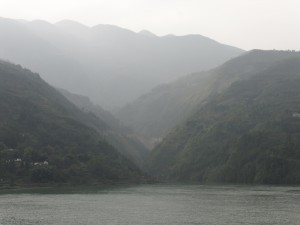 known for its twelve misty peaks that soar above the water and are often hidden in the swirling mist. Six peaks line the north side of the river and six stand to the south. The most famous peak, Shennu Feng (Goddess Peak), is said to resembles the figure of a kneeling maiden which legend claims is the embodiment of Yao Ji, the 23rd daughter of the Queen Mother of the West. As the story goes, Yao Ji, accompanied by 11 handmaidens, was sent to oversee the Jade Pool of the Western Heaven, but instead she stayed here to protect the boats from the dangerous rapids.
known for its twelve misty peaks that soar above the water and are often hidden in the swirling mist. Six peaks line the north side of the river and six stand to the south. The most famous peak, Shennu Feng (Goddess Peak), is said to resembles the figure of a kneeling maiden which legend claims is the embodiment of Yao Ji, the 23rd daughter of the Queen Mother of the West. As the story goes, Yao Ji, accompanied by 11 handmaidens, was sent to oversee the Jade Pool of the Western Heaven, but instead she stayed here to protect the boats from the dangerous rapids.
Lesser Three Gorges Wushan, at the confluence of the Yangtze and Daning River, one of 700 tributaries of the Yangtze, sits just north of the entrance to the Wu (Witches) Gorge. Dating from the 16th century B.C., Wushan is the administrative center of Wushan County, a mountainous region encompassing the Daning River Valley and half of the Wu Gorge.
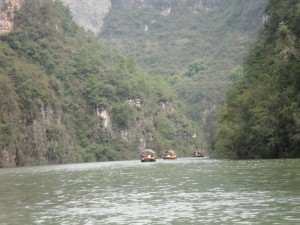 Here we changed to a smaller boat, call a peapod, for the 20 mile-trip up the Daning River through beautiful scenery along three smaller gorges. Once our peapod left the muddy brown Yangtze, she sailed on clear green waters occasionally passing terraced fields cultivated year round, fishing settlements, caves, mountain goats grazing on the hillsides, and monkeys darting about.
Here we changed to a smaller boat, call a peapod, for the 20 mile-trip up the Daning River through beautiful scenery along three smaller gorges. Once our peapod left the muddy brown Yangtze, she sailed on clear green waters occasionally passing terraced fields cultivated year round, fishing settlements, caves, mountain goats grazing on the hillsides, and monkeys darting about.
The first narrow passage, called Dragon Gate Gorge, has cliffs towering to 2,500 to 3,500 feet. There are remains of an ancient plank walkway extending the length of the gorges which provided access to salt mines further up river. Misty Gorge, the second passage, has one of the most curious sights – suspended on a precipice high up on the cliff-face is a 2,000 year old “hanging” coffin of the Ba people who inhabited the region. At one time hundreds of coffins suspended from seemingly inaccessible areas on the cliffs, were seen in the Three Gorges and the Daning River areas. The Emerald Green Gorge, the farthest passage from Wushan, is well named for its lush bamboo grooves and foliage. Along the way, we spotted a small mountainside castle from the Ming period, all but hidden in the heavy foliage. At the end of the journey, we were taken back to the dock via a modern version of a sampan.
After dinner aboard the Victoria Prince, we enjoyed one of the highlights of 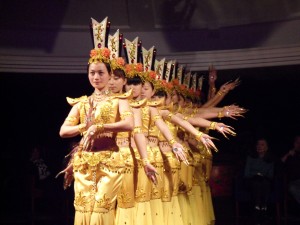 the cruise – a show of magnificent traditional Chinese fashions dating from ancient times to the last century. A very talented group from our wait staff were the models and it was hard to decide which were the loveliest – the exquisite costumes or the beautiful models. Luther provided commentary, explaining the period and status of those who might wear each of the richly designed fashions. The following evening, another fashion show featured some costumes of the 56 different ethnic minorities in China. (I later learned that Victoria Cruises hires staff with musical, dance and other talent specifically to showcase Chinese culture through them.)
the cruise – a show of magnificent traditional Chinese fashions dating from ancient times to the last century. A very talented group from our wait staff were the models and it was hard to decide which were the loveliest – the exquisite costumes or the beautiful models. Luther provided commentary, explaining the period and status of those who might wear each of the richly designed fashions. The following evening, another fashion show featured some costumes of the 56 different ethnic minorities in China. (I later learned that Victoria Cruises hires staff with musical, dance and other talent specifically to showcase Chinese culture through them.)
Day 3 Xiling Gorge and the Three Gorges Dam
The last of the Three Gorges is the longest (41 miles) and the deepest with cliff walls rising to 4,000 feet. Xiling Xiat is actually comprised of seven smaller gorges with such names as Military Books and Precious Sword, Ox Liver and Horse Lungs, and Yellow Cat — all based upon ancient legends.
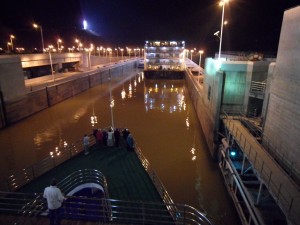 The highlight of the day is the passage through the locks of the Three Gorges Dam. It was 8:00 p.m. by the time we reach our station but floodlights enabled us to see the operation. The boat’s top deck was the best vantage point to watch the gigantic lock doors close behind us. A large marker on the lock walls, indicating the water level, was fun to watch as we dropped through the lock. The final reading: 180 meters (594 feet).
The highlight of the day is the passage through the locks of the Three Gorges Dam. It was 8:00 p.m. by the time we reach our station but floodlights enabled us to see the operation. The boat’s top deck was the best vantage point to watch the gigantic lock doors close behind us. A large marker on the lock walls, indicating the water level, was fun to watch as we dropped through the lock. The final reading: 180 meters (594 feet).
The following morning our boat stopped at Sandouping, about midway in the Xiling Gorge and the site of the Three Gorges Dam and Hydroelectric 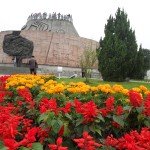 Power Plant, China’s ambitious engineering project. Seventeen years in the making and costing $30 billion, the dam is 610 feet high and over a mile wide. Begun in 1994, the 372 mile-long reservoir stretching from Chongqing to Yichang is almost filled. The power plant, completed in 2009, is driven by the world’s largest turbines with the generating capacity of 18 nuclear power plants.
Power Plant, China’s ambitious engineering project. Seventeen years in the making and costing $30 billion, the dam is 610 feet high and over a mile wide. Begun in 1994, the 372 mile-long reservoir stretching from Chongqing to Yichang is almost filled. The power plant, completed in 2009, is driven by the world’s largest turbines with the generating capacity of 18 nuclear power plants.
Here are the statistics: The Three Gorges Dam is 6,605 feet (2,335 meters) long, 610 (185 meters) high, 59 feet (18 meters) wide on the top and 429 feet (130 meters) wide at the bottom. The dam has raised the river to a level of 578 feet (175 meters) above sea level. The reservoir has a storage capacity of 39.9 billion cubic meters.
For the project even to be possible, approximately 1.5 million people were moved to new towns at higher ground along the shores of the reservoir and approximately 570,000 acres of farmland, village, and towns in 19 counties and thousands of their homes, temples, and ancient archaeological sites were submerged. Tons of rich topsoil were brought to the higher elevations for agriculture, the mainstay of the displaced people. Centuries-old lifestyles and traditions have been altered forever.
The jury is still out on the long range impact and wisdom of building the dam, but the Chinese point to four goals that they say justify the huge project: Control the river’s frequent floods that impacted 15 million people in the Yangtze region; improve irrigation; provide greatly needed electricity; and improve navigation on the river materially benefiting the region and the country.
Yichang at the exit of the Xiling Gorge is the economic and cultural center of the western Hubei Province and the terminus of 3 or 4 night Yangtze cruises where passengers normally board their flights to Shanghai.
Day 4 – Wuhan Set at the confluence of the Yangtze River and Han River, the longest tributary of the Yangtze, Wuhan is the biggest city in central China and composed of three separate cities: Wuchang, Hankou, and Hanyang. Wuhan is also the capital of Hubei province, a region where the land is so productive that a Chinese proverb says “a good harvest in Hunan and Hubei would feed the whole country.”
At the end of the 19th century under the Qing Dynasty (1644-1911), factories were built and credited with beginning the industrialization of China. A tour of the modern city lead us to the town’s gem – the extraordinary Hubei Regional Museum, dedicated to artifacts from the tomb of Marquis Yi of Zeng, undisturbed since the feudal king was buried 2,400 years ago. The remarkable discovery, excavated in 1978, unearthed more than 15,000 pieces and include an astonishing variety of ritual vessels, 125 musical instruments, cooking vessels, stone chimes and bronze bells, weapons, gold and jade wares – all amazingly well preserved and beautifully displayed with Chinese and English labels.
Day 5 – Huangshan The biggest surprise of the cruise was the excursions to the Yellow Mountain, almost ignored in the list of China’s 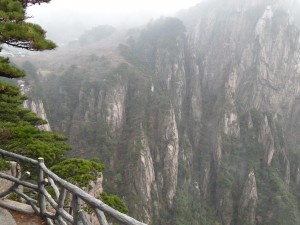 greatest attractions, even though it is on the UNESCO World Heritage list. Located in the lower Yangtze in Anhui province, Huangshan is the gateway to the most spectacular scenery in China. It gets my vote for the World’s Top Ten.
greatest attractions, even though it is on the UNESCO World Heritage list. Located in the lower Yangtze in Anhui province, Huangshan is the gateway to the most spectacular scenery in China. It gets my vote for the World’s Top Ten.
The mountain range has 72 peaks which reach almost 6,000 feet above sea level. All have names such as the three highest ones – Lotus Peak, Heavenly Capital Peak, and Peak of Brightness, and have inspired traditional Chinese landscape painting since ancient times.
Our two-hour motorcoach drive passed through farmed low lands on an excellent highway until the last 30 minutes which wound up the mountain to the Tai Ping Cable Station. There, we boarded a large cable car that conveyed us through the mist encircled mountains to 3,800 ft. In addition to their beauty and sheer magnitude, the soaring mountains are known for their unusual features: The “Sea of Clouds,” undulating mist reminiscent of the ocean waves, pass constantly through valleys and around their peaks.
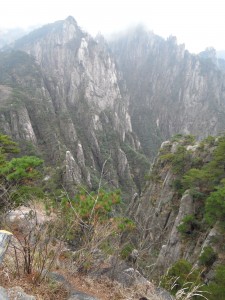 Another unusual feature: Pine trees grow from almost every crevice of the rocky mountains. Each tree, green and full with its gnarled roots and branches, is a marvel. With no apparent soil to nourish them, it’s a mystery how they grow. The most famous pine trees have such names as Greeting the Guests and Lying Dragon. Another feature are the strange rock formations. On a map the most distinguished ones have such inspired names as Monkey Gazing at the Sea and Squirrel Leaping up to the Peak.
Another unusual feature: Pine trees grow from almost every crevice of the rocky mountains. Each tree, green and full with its gnarled roots and branches, is a marvel. With no apparent soil to nourish them, it’s a mystery how they grow. The most famous pine trees have such names as Greeting the Guests and Lying Dragon. Another feature are the strange rock formations. On a map the most distinguished ones have such inspired names as Monkey Gazing at the Sea and Squirrel Leaping up to the Peak.
From the cable station a series of excellent walks and trails wind through the pine forests along the edge of the mountains offering extensive views across the landscape and down thousands of feet to the valleys. If you think Zion or Bryce Canyon National Park in Utah is a showstopper, you will love the Yellow Mountains. Incidentally, there’s nothing yellow about them. The name comes from the Emperor who first popularized Mt. Huang and whose name in Chinese sounds like the word for “yellow.”
Day 6 – Nanjing Situated in the lower reaches of the Yangtze River, Nanjing is the capital of Jiangsu province and has always been important due to its strategic location. From the third to the 14th centuries, eight dynasties established their capitals here. Zhu Yuan Zhang, founder of the Ming Dynasty, made Nanjing his capital and embellished it with palaces, temples, and pagodas. He enlarged the city walls to make them the longest city wall in the world – some 20 miles (12 miles remain).
In 1842, the British forced the Imperial Qing government to sign the Treaty of Nanking ending the first Opium War, ceding the territory of Hong Kong and opening four Chinese ports to foreign trade. Following the revolution of 1911, Nanjing became the capital of the Republic of China. In 1937, the Japanese occupied Nanjing and almost 300,000 residents perished in what became known as the “Rape of Nanjing.” In early 1949, Mao’s army entered Nanjing and drove the Nationalist government to Taiwan. Today, tree-lined boulevards crowded with people, cars and motor scooters are typical of urban China with Walmart, McDonald’s and other familiar U.S. trademarks. Yet, Nanjing shows its age much more than Beijing or Shanghai.
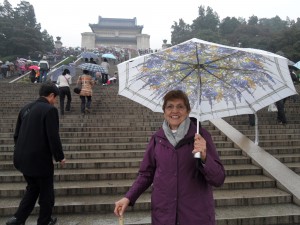 Its most famous landmark today is the Mausoleum of Dr. Sun Yat Sen, who is known as the father of modern China. Completed in 1929, the memorial sits on a hill top in a vast park. A wide pathway lined with flower beds and huge Himalayan Pines leads to the mausoleum with a marble statue of Dr. Sun Yat Sen via 392 steps, representing the 392 delegates of his parliament.
Its most famous landmark today is the Mausoleum of Dr. Sun Yat Sen, who is known as the father of modern China. Completed in 1929, the memorial sits on a hill top in a vast park. A wide pathway lined with flower beds and huge Himalayan Pines leads to the mausoleum with a marble statue of Dr. Sun Yat Sen via 392 steps, representing the 392 delegates of his parliament.
Nanjing has several remnants from the Ming and late Qing dynasties, but the most interesting and popular site, Fu Zi Miao or the Confucius Temple, 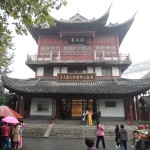 is not to be missed. It is, in fact, a newly developed area made to look old with Qing-style buildings housing shops, restaurants and a bustling bazaar centered by a reconstructed Confucius Temple from the Song Dynasty destroyed by the Japanese in the 1940’s. Here, we found the nicest Chinese products and souvenirs at great prices — with some bargaining – of the trip.
is not to be missed. It is, in fact, a newly developed area made to look old with Qing-style buildings housing shops, restaurants and a bustling bazaar centered by a reconstructed Confucius Temple from the Song Dynasty destroyed by the Japanese in the 1940’s. Here, we found the nicest Chinese products and souvenirs at great prices — with some bargaining – of the trip.
Day 7 – Shanghai We woke up in China’s largest and most dynamic city, with a population of 18 million. Passengers who are not on tours spending a few days here, headed to Shanghai’s Pudong International Airport. It’s useful to know that the cruise dock is located at the northwestern end of the city, while the airport is at the southeastern end. It’s up to an hour’s taxi ride, depending on the traffic, and costs about US$40.
Victoria Prince sails on 3 to 9 days cruises, either upstream from Shanghai or from Yichang/Wuhan or downstream from Chongqing.
© by Kay Showker

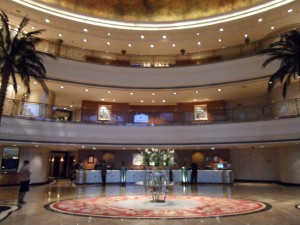
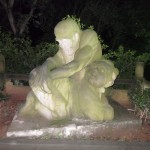
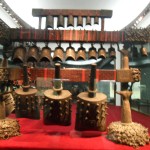
Leave a Reply